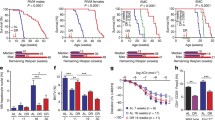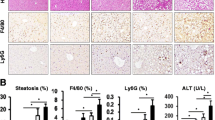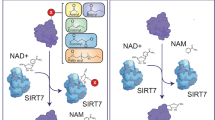Abstract
BRG1 (Brahma-related gene 1) is a member of the SWI/SNF (switch/sucrose nonfermentable) chromatin remodeling complex which utilizes the energy from ATP hydrolysis for its activity. In addition to its role of regulating the expression of a vast array of genes, BRG1 mediates DNA repair upon genotoxic stress and regulates senescence. During organismal ageing, there is accumulation of unrepaired/unrepairable DNA damage due to progressive breakdown of the DNA repair machinery. The present study investigates the expression level of BRG1 as a function of age in the liver of 5- and 21-month-old female mice. It also explores the impact of dietary restriction on BRG1 expression in the old (21-month) mice. Salient findings of the study are: Real-time PCR and Western blot analyses reveal that BRG1 levels are higher in 5-month-old mice but decrease significantly with age. Dietary restriction increases BRG1 expression in the 21-month-old mice, nearly restoring it to the level observed in the younger group. Similar expression patterns are observed for DNA damage response genes ATM (Ataxia Telangiectasia Mutated) and ATR (Ataxia Telangiectasia and Rad3-related) with the advancement in age and which appears to be modulated by dietary restriction. BRG1 transcriptionally regulates ATM as a function of age and dietary restriction. These results suggest that BRG1, ATM and ATR are downregulated as mice age, and dietary restriction can restore their expression. This implies that dietary restriction may play a crucial role in regulating BRG1 and related gene expression, potentially maintaining liver repair and metabolic processes as mice age.






Similar content being viewed by others
References
Aalfs JD, Kingston RE (2000) What does “chromatin remodeling” mean? Trends Biochem Sci 25(11):548–555. https://doi.org/10.1016/s0968-0004(00)01689-3
Aydin S, Atukeren P, Cakatay U, Uzun H, Altuğ T (2010) Gender-dependent oxidative variations in liver of aged rats. Biogerontology 11(3):335–346. https://doi.org/10.1007/s10522-009-9257-8
Bacalini MG, Franceschi C, Gentilini D, Ravaioli F, Zhou X, Remondini D et al (2018) Molecular aging of human liver: an epigenetic/transcriptomic signature. J Gerontol A Biol Sci Med Sci 74(1):1–8
Bai M, Ti D, Mei Q, Liu J, Yan X et al (2020) The role of posttranslational modifications in DNA repair. BioMed Res Int. https://doi.org/10.1155/2020/7493902
Bannister A, Kouzarides T (2011) Regulation of chromatin by histone modifications. Cell Res 21:381–395. https://doi.org/10.1038/cr.2011.22
Benayoun BA, Pollina EA, Brunet A (2015) Epigenetic regulation of ageing: linking environmental inputs to genomic stability. Nat Rev Mol Cell Biol 16(10):593
Bochkis IM, Przybylski D, Chen J, Regev A (2014) Changes in nucleosome occupancy associated with metabolic alterations in aged mammalian liver. Cell Rep 9(3):996–1006
Booth LN, Brunet A (2016) The aging epigenome. Mol Cell 62(5):728–744
Bradford MM (1976) A rapid and sensitive method for the quantification of microgram quantities of protein using the principle of protein-dye binding. Anal Biochem 72:248–254
Chen JH, Hales CN, Ozanne SE (2007) DNA damage, cellular senescence and organismal ageing: causal or correlative? Nucleic Acids Res 35(22):7417–7428. https://doi.org/10.1093/nar/gkm681
Chung MH, Kasai H, Nishimura S, Yu BP (1992) Protection of DNA damage by dietary restriction. Free Radic Biol Med 12(6):523–525. https://doi.org/10.1016/0891-5849(92)90105-p
Cieslak KP, Baur O, Verheij J, Bennink RJ, van Gulik TM (2016) Liver function declines with increased age. HPB (oxford) 18(8):691–696. https://doi.org/10.1016/j.hpb.2016.05.011
Durand F, Levitsky J, Cauchy F, Gilgenkrantz H, Soubrane O, Francoz C (2018) Age and liver transplantation. J Hepatol. https://doi.org/10.1016/j.jhep.2018.12.009
Garinis GA, van der Horst GT, Vijg J, Hoeijmakers JH (2008) DNA damage and ageing: new-age ideas for an age-old problem. Nat Cell Biol 10(11):1241–1247. https://doi.org/10.1038/ncb1108-1241
Gee LMV, Barron-Millar B, Leslie J et al (2023) Anti-cholestatic therapy with obeticholic acid improves short-term memory in bile duct–ligated mice. Am J Pathol 193:11–26
Gorbunova V, Seluanov A (2016) DNA double strand break repair, aging and the chromatin connection. Mutat Res 788:2–6
Gorbunova V, Seluanov A, Mao Z, Hine C (2007) Changes in DNA repair during aging. Nucleic Acids Res 35(22):7466–7474. https://doi.org/10.1093/nar/gkm756
Goyary D, Sharma R (2008) Late onset of dietary restriction reverses age-related decline of malate-aspartate shuttle enzymes in the liver and kidney of mice. Biogerontology 9:11–18
Green CL, Lamming DW, Fontana L (2022) Molecular mechanisms of dietary restriction promoting health and longevity. Nat Rev Mol Cell Biol 23(1):56–73. https://doi.org/10.1038/s41580-021-00411-4
Hadem IK, Sharma R (2016) Age-and tissue-dependent modulation of IGF-1/PI3K/Akt protein expression by dietary restriction in mice. Horm Metab Res 48(3):201–206. https://doi.org/10.1055/s-0035-1559770
Hahn O, Stubbs TM, Reik W, Grönke S, Beyer A, Partridge L (2018) Hepatic gene body hypermethylation is a shared epigenetic signature of murine longevity. PLoS Genet 14(11):e1007766
Haley-Zitlin V, Richardson A (1993) Effect of dietary restriction on DNA repair and DNA damage. Mutat Res 295(4–6):237–245. https://doi.org/10.1016/0921-8734(93)90023-v
Hargreaves DC (2021) Chromatin openness requires continuous SWI/SNF activity. Nat Genet 53(3):263–264. https://doi.org/10.1038/s41588-021-00781-7
Heydari AR, Unnikrishnan A, Lucente LV, Richardson A (2007) Caloric restriction and genomic stability. Nucleic Acids Res 35(22):7485–7496. https://doi.org/10.1093/nar/gkm860
Horn PJ, Peterson CL (2006) Heterochromatin assembly: a new twist on an old model. Chromosome Res 14(1):83–94. https://doi.org/10.1007/s10577-005-1018-1
Imbalzano AN, Imbalzano KM, Nickerson JA (2013) BRG1, a SWI/SNF chromatin remodeling enzyme ATPase, is required for maintenance of nuclear shape and integrity. Commun Integr Biol 6(5):e25153. https://doi.org/10.4161/cib.25153
Ishaq A, Schröder J, Edwards N, von Zglinicki T, Saretzki G (2018) Dietary restriction ameliorates age-related increase in DNA damage, senescence and inflammation in mouse adipose tissuey. J Nutr Health Aging 22(4):555–561. https://doi.org/10.1007/s12603-017-0968-2
Jensen-Cody SO, Potthoff MJ (2021) Hepatokines and metabolism: deciphering communication from the liver. Mol Metab 44:101138. https://doi.org/10.1016/j.molmet.2020.101138
Kanungo M, Koul O, Reddy KR (1970) Concomitant studies on RNA and protein synthesis in tissues of rats of various ages. Exp Gerontol 5:261–269
Kharbhih WJ, Sharma R (2014) Age-dependent increased expression and activity of inorganic pyrophosphatase in the liver of male mice and its further enhancement with short- and long-term dietary restriction. Biogerontology 15:81–86
Khatir I, Brunet MA, Meller A, Amiot F, Patel T et al (2023) Decoupling of mRNA and protein expression in aging brains reveals the age-dependent adaptation of specific gene subsets. Cells 12(4):615. https://doi.org/10.3390/cells12040615
Kuk MU, Kim JW, Lee YS, Cho KA, Park JT, Park SC (2019) Alleviation of senescence via ATM inhibition in accelerated aging models. Mol Cells 42(3):210–217. https://doi.org/10.14348/molcells.2018.0352
Lee HS, Park JH, Kim SJ, Kwon SJ, Kwon J (2010) A cooperative activation loop among SWI/SNF, gamma-H2AX and H3 acetylation for DNA double-strand break repair. EMBO J 29(8):1434–1445
Lienhard A, Schäffer S (2019) Extracting the invisible: obtaining high quality DNA is a challenging task in small arthropods. PeerJ 7:e6753. https://doi.org/10.7717/peerj.6753
Lin LS, Guo ZY, He EJ et al (2023) SIRT2 regulates extracellular vesicle-mediated liver-bone communication. Nat Metab 5:821–841
Lin Y, Li Y, Liang G, Yang X, Yang J, Hu Q, Sun J, Zhang C, Fang H, Liu A (2024) Single-cell transcriptome analysis of aging mouse liver. FASEB J 38(4):e23473. https://doi.org/10.1096/fj.202302282R
Livak KJ, Schmittgen TD (2001) Analysis of relative gene expression data using real-time quantitative PCR and the 2−ΔΔCT method. Methods 25:402–408
Lombard DB, Chua KF, Mostoslavsky R, Franco S, Gostissa M, Alt FW (2005) DNA repair, genome stability, and aging. Cell 120(4):497–512. https://doi.org/10.1016/j.cell.2005.01.028
López-Otín C, Blasco MA, Partridge L, Serrano M, Kroemer G (2023) Hallmarks of aging: an expanding universe. Cell 186(2):243–278. https://doi.org/10.1016/j.cell.2022.11.001
Lu K, Shi TS, Shen SY et al (2022) Defects in a liver-bone axis contribute to hepatic osteodystrophy disease progression. Cell Metab 34:441–457
Lué A, Solanas E, Baptista P, Lorente S, Araiz JJ, Garcia-Gil A, Serrano MT (2016) How important is donor age in liver transplantation? World J Gastroenterol 22:4966. https://doi.org/10.3748/wjg.v22.i21.4966
Ma J, Zhou Q, Li H (2017) Gut microbiota and nonalcoholic fatty liver disease: insights on mechanisms and therapy. Nutrients 9:1124. https://doi.org/10.3390/nu9101124
MacRae SL, Croken MM, Calder RB, Aliper A, Milholland B, White RR, Zhavoronkov A, Gladyshev VN, Seluanov A, Gorbunova V, Zhang ZD, Vijg J (2015) DNA repair in species with extreme lifespan differences. Aging (albany NY) 7(12):1171–1184. https://doi.org/10.18632/aging.100866
Majaw T, Sharma R (2015) Arginase I expression is upregulated by dietary restriction in the liver of mice as a function of age. Mol Cell Biochem 407(1–2):1–7. https://doi.org/10.1007/s11010-015-2448-5
Maréchal A, Zou L (2013) DNA damage sensing by the ATM and ATR kinases. Cold Spring Harb Perspect Biol 5(9):a012716. https://doi.org/10.1101/cshperspect.a012716
Martins R, Lithgow GJ, Link W (2016) Long live FOXO: unraveling the role of FOXO proteins in aging and longevity. Aging Cell 15(2):196–207
Meer MV, Podolskiy DI, Tyshkovskiy A, Gladyshev VN (2018) A whole lifespan mouse multi-tissue DNA methylation clock. Elife 7:e40675
Merry BJ, Holehan AM, Lewis SE, Goldspink DF (1987) The effects of ageing and chronic dietary restriction on in vivo hepatic protein synthesis in the rat. Mech Ageing Dev 39:189–199
Morsiani C, Bacalini MG, Santoro A, Garagnani P, Collura S et al (2019) The peculiar aging of human liver: a geroscience perspective within transplant context. Ageing Res Rev 51:24–34. https://doi.org/10.1016/j.arr.2019.02.002
Murga M, Bunting S, Montaña MF, Soria R, Mulero F, Cañamero M, Lee Y, McKinnon PJ, Nussenzweig A, Fernandez-Capetillo O (2009) A mouse model of ATR-Seckel shows embryonic replicative stress and accelerated aging. Nat Genet 41(8):891–898. https://doi.org/10.1038/ng.420
Patne K, Rakesh R, Arya V, Chanana UB, Sethy R, Swer PB, Muthuswami R (2017) BRG1 and SMARCAL1 transcriptionally co-regulate DROSHA, DGCR8 and DICER in response to doxorubicin-induced DNA damage. Biochim Biophys Acta Gene Regul Mech 1860(9):936–951. https://doi.org/10.1016/j.bbagrm.2017.07.003
Petr MA, Tulika T, Carmona-Marin LM, Scheibye-Knudsen M (2020) Protecting the aging genome. Trends Cell Biol 30(2):117–132. https://doi.org/10.1016/j.tcb.2019.12.001
Pibiri M (2018) Liver regeneration in aged mice: new insights. Aging (Albany NY) 10(8):1801–1824. https://doi.org/10.18632/aging.101524
Qian M, Liu Z, Peng L, Tang X, Meng F et al (2018) Boosting ATM activity alleviates aging and extends lifespan in a mouse model of progeria. Elife 7:e34836. https://doi.org/10.7554/eLife.34836
Qin Y, Grimm SA, Roberts JD, Chrysovergis K, Wade PA (2020) Alterations in promoter interaction landscape and transcriptional network underlying metabolic adaptation to diet. Nat Commun 11(1):962. https://doi.org/10.1038/s41467-020-14796-x
Rattan SIS (2008) Hormesis in aging. Ageing Res Rev 7(1):63–78. https://doi.org/10.1016/j.arr.2007.03.002
Rattan SIS (2024) Seven knowledge gaps in modern biogerontology. Biogerontology 25(1):1–8. https://doi.org/10.1007/s10522-023-10089-0
Rui L (2014) Energy metabolism in the liver. Compr Physiol 4(1):177–197. https://doi.org/10.1002/cphy.c130024
Ruzankina Y, Pinzon-Guzman C, Asare A, Ong T, Pontano L et al (2007) Deletion of the developmentally essential gene ATR in adult mice leads to age-related phenotypes and stem cell loss. Cell Stem Cell 1(1):113–126. https://doi.org/10.1016/j.stem.2007.03.002
Santos AL, Lindner AB (2017) Protein posttranslational modifications: roles in aging and age-related disease. Oxid Med Cell Longev 2017:5716409. https://doi.org/10.1155/2017/5716409
Sen P, Shah PP, Nativio R, Berger SL (2016) Epigenetic mechanisms of longevity and aging. Cell 166(4):822–839
Sethy R, Rakesh R, Patne K, Arya V, Sharma T, Haokip DT, Kumari R, Muthuswami R (2018) Regulation of ATM and ATR by SMARCAL1 and BRG1. Biochim Biophys Acta Gene Regul Mech 1861(12):1076–1092. https://doi.org/10.1016/j.bbagrm.2018.10.004
Sinha S, Verma S, Chaturvedi MM (2016) Differential expression of SWI/SNF chromatin remodeler subunits Brahma and Brahma-related gene during drug-induced liver injury and regeneration in mouse model. DNA Cell Biol 35(8):373–384. https://doi.org/10.1089/dna.2015.3155
Swer PB, Sharma R (2021) ATP-dependent chromatin remodelers in ageing and age-related disorders. Biogerontology 22(1):1–17. https://doi.org/10.1007/s10522-020-09899-3
Thompson RF, Atzmon G, Gheorghe C, Liang HQ, Lowes C, Greally JM et al (2010) Tissue-specific dysregulation of DNA methylation in aging. Aging Cell 9(4):506–518
Trotter KW, Archer TK (2008) The BRG1 transcriptional coregulator. Nucl Recept Signal 6:e004. https://doi.org/10.1621/nrs.06004
Vermeij WP, Dollé ME, Reiling E, Jaarsma D, Payan-Gomez C et al (2016) Restricted diet delays accelerated ageing and genomic stress in DNA-repair-deficient mice. Nature 537(7620):427–431. https://doi.org/10.1038/nature19329
Wang G, Fu Y, Hu F, Lan J, Xu F, Yang X, Luo X, Wang J, Hu J (2017a) Loss of BRG1 induces CRC cell senescence by regulating p53/p21 pathway. Cell Death Dis 8(2):e2607. https://doi.org/10.1038/cddis.2017.1
Wang T, Tsui B, Kreisberg JF, Robertson NA, Gross AM, Yu MK et al (2017b) Epigenetic aging signatures in mice livers are slowed by dwarfism, calorie restriction and rapamycin treatment. Genome Biol 18(1):57
Wang B, Kaufmann B, Engleitner T, Lu M, Mogler C et al (2019) Brg1 promotes liver regeneration after partial hepatectomy via regulation of cell cycle. Sci Rep 9(1):2320. https://doi.org/10.1038/s41598-019-38568-w
Wang K, Liu H, Hu Q, Wang L, Liu J, Zheng Z, Zhang W, Ren J, Zhu F, Liu GH (2022) Epigenetic regulation of aging: implications for interventions of aging and diseases. Signal Transduct Target Ther 7(1):374. https://doi.org/10.1038/s41392-022-01211-8
Wang J, Zhang W, Liu X, Kim M, Zhang K, Tsai RYL (2023) Epigenome-wide analysis of aging effects on liver regeneration. BMC Biol 21(1):30. https://doi.org/10.1186/s12915-023-01533-1
White RR, Milholland B, MacRae SL, Lin M, Zheng D, Vijg J (2015a) Comprehensive transcriptional landscape of aging mouse liver. BMC Genom 16:899. https://doi.org/10.1186/s12864-015-2061-8
White RR, Milholland B, de Bruin A, Curran S, Laberge RM et al (2015b) Controlled induction of DNA double-strand breaks in the mouse liver induces features of tissue ageing. Nat Commun 6:6790. https://doi.org/10.1038/ncomms7790
Woolbright BL, Jaeschke H (2015) Xenobiotic and endobiotic mediated interactions between the cytochrome P450 system and the inflammatory response in the liver. Adv Pharmacol 74:131–161. https://doi.org/10.1016/bs.apha.2015.04.001
Wu Y, Dong J-H, Dai Y-F et al (2023) Hepatic soluble epoxide hydrolase activity regulates cerebral Aβ metabolism and the pathogenesis of Alzheimer’s disease in mice. Neuron 111:2847–2862
Yu Z, Sunchu B, Fok WC, Alshaikh N, Pérez VI (2015) Gene expression in the liver of female, but not male mice treated with rapamycin resembles changes observed under dietary restriction. Springerplus 4:174. https://doi.org/10.1186/s40064-015-0909-7
Zhou X, Sen I, Lin XX, Riedel CG (2018) Regulation of age-related decline by transcription factors and their crosstalk with the epigenome. Curr Genomics 19(6):464–482. https://doi.org/10.2174/1389202919666180503125850
Acknowledgements
Authors thank the Department of Biochemistry, NEHU and the UGC-DRSIII programme for laboratory facilities. PBS acknowledges funding from University Grants Commission (UGC) for this work under the DS Kothari Postdoctoral Fellowship (DSKPDF) scheme (File No.F.4-2/2006 (BSR)/BL/18-19/0273). BK thanks UGC for fellowship. The authors also thank Prof SR Joshi, Department of Biotechnology and Bioinformatics, NEHU for providing sonication facilities.
Author information
Authors and Affiliations
Contributions
RS and DS planned the work outlay whereas PBS and BK executed the research work embodies in the present manuscript. PBS wrote the main manuscript whereas RS and DS did the necessary correction of text in the manuscript.
Corresponding author
Ethics declarations
Conflict of interest
The authors have declared that no conflict of interest exists with the content of this article.
Additional information
Publisher's Note
Springer Nature remains neutral with regard to jurisdictional claims in published maps and institutional affiliations.
Rights and permissions
Springer Nature or its licensor (e.g. a society or other partner) holds exclusive rights to this article under a publishing agreement with the author(s) or other rightsholder(s); author self-archiving of the accepted manuscript version of this article is solely governed by the terms of such publishing agreement and applicable law.
About this article
Cite this article
Swer, P.B., Kharbuli, B., Syiem, D. et al. Age-related decline in the expression of BRG1, ATM and ATR are partially reversed by dietary restriction in the livers of female mice. Biogerontology (2024). https://doi.org/10.1007/s10522-024-10117-7
Received:
Accepted:
Published:
DOI: https://doi.org/10.1007/s10522-024-10117-7




